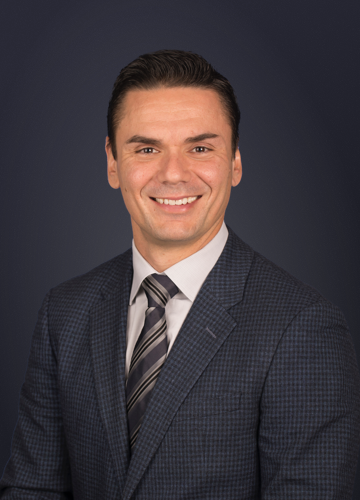 Tony Pialis is a visionary entrepreneur focused on developing
Tony Pialis is a visionary entrepreneur focused on developing
technologies for next generation connectivity. In the last twenty 20 years, he has co-founded three semiconductor IP companies, all exclusively targeting connectivity IP. Tony is currently the CEO of Alphawave IP Inc, a leader in delivering multi-standard wireline IP for AI, datacenter and 5G networks.
Starting in 1999, Tony was an early founder of Snowbush
Microelectronics Inc, a Canadian-based analog design services and IP organization that subsequently became a leading supplier of analog and mixed-signal IP cores. Snowbush was acquired by Gennum/Semtech in 2007 and is currently part of Rambus.
In 2008, Tony founded V Semiconductor, where he served as President and CEO. V Semiconductor was a leader in delivering 10Gbps Ethernet and PCI-Express Gen3 IP solutions to top tier semiconductor manufacturers. In 2012, Intel acquired V Semiconductor Inc.
At Intel, Tony was the Vice President of Analog and Mixed-Signal IP. His organization was responsible for developing analog IP portfolios for both networking/datacenter and portable devices. During his tenure at Intel, Tony and his organization won the prestigious Intel Achievement Award for successfully delivering next generation Ethernet and PCI-Express SerDes solutions on Intel’s 22nm and 14nm process technologies.
Tony earned bachelor’s and master’s degree in electrical engineering from the University of Toronto. He has been granted approximately 10 patents for mixed-signal design innovations.
What brought you to semiconductors?
I won my first professional internship upon completion of my third year of university study. It was at a fast-growing graphics company based in Toronto, Canada. I was hired into their analog design team, working on timing and interface circuits. Back in the late 90s, 500MHz was considered a fast interface, especially when built on a 0.35um CMOS technology, using an up-and-coming foundry – TSMC. I loved my internship experience. I found mixed-signal semiconductor design was the perfect blend of mathematics, physics, communications, coding, along with a twist of creative design flair thrown in. It activated and challenged all aspects of my engineering studies to date. I had never felt so fulfilled upon the completion of my first internship project – building a C-model of a Phase-Locked Loop. After my internship ended, I was sold on becoming a mixed-signal semiconductor designer and focused the remaining portion of my undergraduate and graduate studies in this space. Today as an employer, I repeat this same internship story to all the interns we hire. It illustrates how powerful and beneficial work internships can be to students. It provides an early insight into industry and disciplines, while students are still at school and have the luxury of choice. As I look back, that internship was a pivotal moment in my professional career development.
What is the AlphaWave backstory?
I am a serial entrepreneur, having founded and successfully sold two previous startups – Snowbush Microelectronics and V Semiconductor, both having developed traditional analog based SerDes architectures. The introduction of PAM4, made analog based SerDes architectures much more sensitive to process, voltage, and temperature variations. In modern nanometer finfet technologies, building transistors involves stacking individual electrons, given the tiny dimensions of the transistors. Thus, the construction of precise, analog circuits that can sustain stressful environmental variations is extremely difficult. I came to the realization that a new approach would be needed in our industry, to scale data rates to higher speeds, and processes to smaller geometries. An architectural revolution would be needed that moved SerDes away from traditional analog approaches, towards novel digital and DSP based architectures. I wanted to lead this revolution. This was the catalyst and ultimate inspiration for AlphaWave.
In 2017 I set to work assembling a premier executive team, finding lead customers, and scaling the organization. Like my other businesses, we avoided institutional investors, and built the company the hard way, by bootstrapping it with our own money and with income from lead customers. Fast forward three years, we are closing 2020 with year over year, triple digit growth, and in 2020 we were awarded the High Speed SerDes IP Open Innovation Platform (OIP) Partner of the Year award by TSMC. I am thrilled by the eager market demand for our DSP based silicon IPs and am even more excited about our prospects in 2021.
What customer challenges are you addressing?
Building leading-edge semiconductor System-On-Chips (“SOCs”) on state-of-the-art semiconductor processes, requires integration of tens of billions of transistors. Building these SOCs is as complex an act, as building a modern-day city. It involves thousands of man years of effort, and upwards of half a billion dollars of investment to design a single SOC. No one company, can do it all themselves. However, these developments remain highly profitable due to the fact, that the world increasingly has more data content that needs to be shared, distributed, analyzed, and processed. Given that building a leading-edge SOC is analogous to building a data driven city, we build the “data highways” that moves the data within and across these data cities. We deliver silicon IPs that makes it faster, lower power and lower cost to share data and content among devices, data centers, and across the world. We target the fast-growing markets, such as AI, 5G, Data Centers, and storage, for our Silicon IPs. In a span of three years, we have become the industry benchmark for the deployment of leading-edge “data highways.”
What is your competitive positioning?
Simply said, we deliver silicon IPs that makes it faster, lower power and lower cost to share content and data. The silicon IPs we deliver today run over 100Gbps – that is one hundred thousand, million bits per second. These are the fastest, most sophisticated parts of modern SOCs. Our job, like most successful technology companies, is to absorb all the complexity and to make our technology easy and fool proof to the end user. Our approach has been to use the power of DSP and adaptive algorithms, to predict ever-changing environmental and silicon changes, and to compensate for them so as not to impact performance. Furthermore, DSP approaches are especially well suited and leverages technology scaling much more than traditional analog SerDes architectures. Foundries appreciate this and are embracing our technology and approaches. As my competitors try to adjust to this new DSP based approach for building SerDes, we have already moved forward to next generation rates and solutions for doubling the capacity of our data highways. We are not technology followers. Our singular focus is on being the Premier Industry Leader for delivering high performance interface IPs to power the next generation of data highway.
Congratulations on being TSMC OIP partner of the year. What are the factors that contributed to getting this award after just 3 years of business?
The TSMC OIP Partner of the Year award for High-Speed SerDes IP is a prestigious honor for me personally, and the entire AlphaWave team. It was awarded to us due to our success in the marketplace. In just three short years since we were founded, we have built a compelling portfolio of silicon IPs for TSMC processes and their customers. The Partner of the Year award validates the tremendous customer successes we have experienced in TSMC processes. As we innovate and expand our portfolio with TSMC in 5nm and beyond, we look forward to continuing the enablement of our mutual tier-1 customers, globally.
What does the next 12 months have in store for AlphaWave?
First off, I have never been as excited for the next twelve months, as I am right now. The prospects of COVID vaccinations, a return to normal world order, and the resulting market take-off, positions our industry extremely well for the next twelve months. During the COVID lockdown, AlphaWave have been doubling down in developing and expanding our Silicon IP portfolio to enable the next generations of SOCs for AI, 5G, Data Centers, and Storage. We have exciting, new product and design win announcements queued up and ready to make in 2021. As fun as it has been to get to this point, I am thrilled to say our most exciting moments lay ahead of us
Also Read:
CEO Interview: Dr. Chouki Aktouf of Defacto
CEO Interview: Andreas Kuehlmann of Tortuga Logic
CEO Interview: Paul Wells of sureCore
Share this post via:






Comments
One Reply to “CEO Interview: Tony Pialis of Alphawave IP”
You must register or log in to view/post comments.